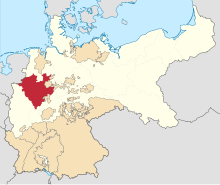Province of Westphalia
This article needs additional citations for verification. (October 2017) |
| Province of Westphalia Provinz Westfalen | |||||||||||||||||||||||||||||
|---|---|---|---|---|---|---|---|---|---|---|---|---|---|---|---|---|---|---|---|---|---|---|---|---|---|---|---|---|---|
| Province of Prussia | |||||||||||||||||||||||||||||
| 1815–1946 | |||||||||||||||||||||||||||||
 Flag
 Coat of arms
| |||||||||||||||||||||||||||||
 Westphalia (red), within the Kingdom of Prussia, within the German Empire | |||||||||||||||||||||||||||||
| Anthem | |||||||||||||||||||||||||||||
| Westfalenlied | |||||||||||||||||||||||||||||
| Capital | Münster | ||||||||||||||||||||||||||||
| Area | |||||||||||||||||||||||||||||
| • Coordinates | 51°58′N 7°38′E / 51.967°N 7.633°ECoordinates: 51°58′N 7°38′E / 51.967°N 7.633°E | ||||||||||||||||||||||||||||
• 1817 | 20,215 km2 (7,805 sq mi) | ||||||||||||||||||||||||||||
| Population | |||||||||||||||||||||||||||||
• 1925 | 4,784,000 | ||||||||||||||||||||||||||||
| History | |||||||||||||||||||||||||||||
• Established | 1815 | ||||||||||||||||||||||||||||
• Disestablished | 1946 | ||||||||||||||||||||||||||||
| Political subdivisions | Arnsberg Minden Münster | ||||||||||||||||||||||||||||
| |||||||||||||||||||||||||||||
The Province of Westphalia (German: Provinz Westfalen) was a province of the Kingdom of Prussia and the Free State of Prussia from 1815[1] to 1946.[2]
History[]
Napoleon Bonaparte founded the Kingdom of Westphalia, which was a client state of the First French Empire from 1807 to 1813. This state shared only the name with the historical region, containing mostly Hessian and Eastphalian regions and only a relatively small part of the region of Westphalia.
Although Prussia had long owned territory in Westphalia, King Frederick William III had preferred to incorporate the Kingdom of Saxony first. It was not until the Congress of Vienna in 1815 that the Province of Westphalia came into being. The province was formed from several territories:
- regions in Westphalia under Prussian rule since before 1800 (the Principality of Minden and the counties of Mark, Ravensberg and Tecklenburg)
- the Bishopric of Münster and Bishopric of Paderborn, acquired by Prussia in 1802–03; the northernmost parts of the geographically enormous Bishopric of Münster, however, became part of the Kingdom of Hanover or the Grand Duchy of Oldenburg
- the small county of Limburg, acquired in 1808
- the Duchy of Westphalia, placed under Prussian rule in 1815 after the Congress of Vienna.
- the Sayn-Wittgensteiner principalities of Hohenstein and Berleburg, along with the principality of Nassau-Siegen (in 1817)
In 1816, the district of Essen was transferred to the Rhine Province.
Economy[]
- 1907
- 18% agriculture
- 59% industry
- 11% trade
After World War II[]
After the end of World War II, the province was merged with the northern half of the Rhine Province to form the German state of North Rhine-Westphalia in 1946, with the addition of the former state of Lippe in 1947.
Maps[]

Upper presidents[]
The Prussian central government appointed upper presidents as their representatives in the province, supervising the implementation of central prerogatives in Westphalia. Between 1920 and 1933 their appointment needed the consent of the provincial diet, in those years directly elected by the Westphalians.
| Term | Name |
|---|---|
| 1816 to 1844 | |
| 1845 to 1846 | |
| 1846 to 1850 | Eduard Heinrich Flottwell |
| 1850 to 1871 | |
| 1871 to 1882 | |
| 1883 to 1889 | |
| 1889 to 1899 | |
| 1899 to 1911 | |
| 1911 to 1919 | |
| 1919 | , DNVP |
| 1919 to 1922 | , Zentrum |
| 1922 | , DNVP |
| 1922 to 1933 | , Zentrum |
| 1933 to 1938 | Ferdinand von Lüninck, DNVP |
| 1938 to 1945 | Alfred Meyer, NSDAP |
| 1945 to 1946 | Rudolf Amelunxen, Zentrum, appointed by the British military government |
Land captains of Westphalia[]
The provincial diet, until 1886 represented by the Westphalian estates of the realm elected their president titled land captain. In the course of strengthening selfrule in the provinces the Westphalian provincial diet was reorganised as the legislation composing of representatives elected from the assemblies of the rural counties and independent cities in 1886. These districts and cities then formed the public-law corporation called the provincial federation (Provinzialverband). The elected speaker of the provincial diet, first titled land director (Landesdirektor), but renamed land captain in 1889, was simultaneously head of the provincial government, called provincial committee (Provinzialausschuss). Between 1920 and 1933 the provincial diet was directly elected by the Westphalian electorate. As of 1933, in the course of the abolition of parliamentarism in Nazi Germany, the land captains were appointed by the central Prussian government, presided over by Hermann Göring, and became subject to the directives of their respective upper president. Kolbow was still elected, by a provincial diet dominated by Nazi mandataries, his successors were appointed, with the diet officially dissolved in 1934. The task of the Westphalian provincial federation is carried on by the , established in 1953 and also including the county comprising the territory of the former Free State of Lippe, disestablished in 1947.
| Term | Name |
|---|---|
| 1886 to 1900 | , titled land director until 1889 |
| 1900 to 1905 | |
| 1905 to 1919 | |
| 1920 to 1933 | , Zentrum |
| 1933 to 1944 | , NSDAP |
| 1944 per pro | , NSDAP |
| 1944 to 1945 | , NSDAP |
| 1945 to 1954 | , appointed by the British military government |
References[]
- ^ lieber, francis (1851). a popular dictionary of arts, sciences, literature, history, politics, and biography. p. 139.
- ^ Mitchell, Maria (2012-10-04). The Origins of Christian Democracy: Politics and Confession in Modern Germany. University of Michigan Press. p. 141. ISBN 978-0472118410.
- States and territories established in 1815
- States and territories disestablished in 1946
- Province of Westphalia
- Provinces of Prussia
- Westphalia culture
- 1815 establishments in Prussia
- 1946 disestablishments in Germany
- 1940s disestablishments in Prussia
